With one owner during its entire life, this 1971 Karmann-Ghia Cabriolet looks like a car that has been the recipient of careful ownership. That original owner has now decided that after 48-years, the time has come to part with the car. Barn Finder Peter R spotted the Karmann-Ghia for us, so thank you so much for that Peter. The Karmann-Ghia is located in Winnipeg, Manitoba, Canada, and is listed for sale here on Kijiji. If you would like to get hold of a pretty cool convertible, all you need to do is be prepared to part with $17,000.
When the owner referred to the color of the Karmann-Ghia as Blood Orange, I did stop for a moment, as I wasn’t aware that this was actually a Volkswagen color. A quick check of some charts shows it referred to as both Blood Orange, and as Bloodorange, so I guess either would be correct. Certainly, the car does present quite nicely, and it is good to see that the damage-prone nose of the car seems to be in good condition. The owner makes no mention of rust issues, but the body looks pretty good, so hopefully, everything under the skin is just as healthy. I will say that the general shape of the Karmann-Ghia lends itself nicely to being a convertible, and as a bonus, the soft-top looks like it is in good condition.
We only get this one photo of the interior, and while the owner does admit that there is some work required, he does reassure us that none of it is urgent. I can see a crack in the dash pad, but the dash itself looks like it is in pretty good condition. We can’t really see the seats, but even if they need new covers, that’s not a particularly difficult or expensive proposition.
With a claimed 71,000 genuine miles under its belt, I tend to agree with the owner that this Karmann-Ghia would be barely run-in. As long as they are correctly maintained, these 1,584cc flat-4 engines are pretty robust. I would have to assume that if the one person has owned the car for 48-years, then they would have a reasonable idea about the correct maintenance. The 60hp that this engine produces is sent to the road via a 4-speed manual transmission. These are a pretty light little car, and the combination of low power and a low center of gravity can make these a really entertaining car to drive if you point them at a piece of twisting road.
The Volkswagen Karmann-Ghia was not a particularly rare car when new, and during the car’s 19-year production run, 445,000 were built. The Cabriolet version is a slightly rarer beast, with only 81,000 rolling off the line for worldwide sale. Good original examples are becoming harder to find these days, and this is a car that seems to fulfill both of those criteria. This means that a cabriolet in average condition can set you back around the $20,000 mark. This one could probably be classed as slightly better than average, and the unspecified interior issues may be the reason why the price has been set where it has. The beauty of these little cars is that they are becoming an unusual sight on our roads, but they are cheap to run and maintain, and mechanical components remain in ready supply. Those seem like pretty sound reasons to buy a Karmann-Ghia.
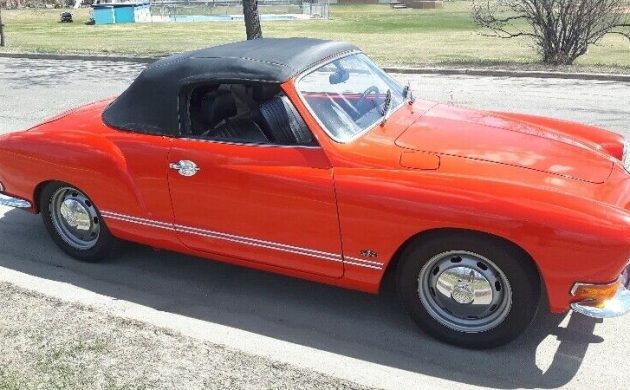
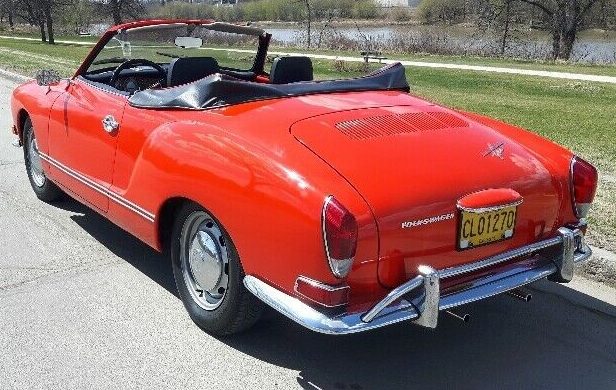
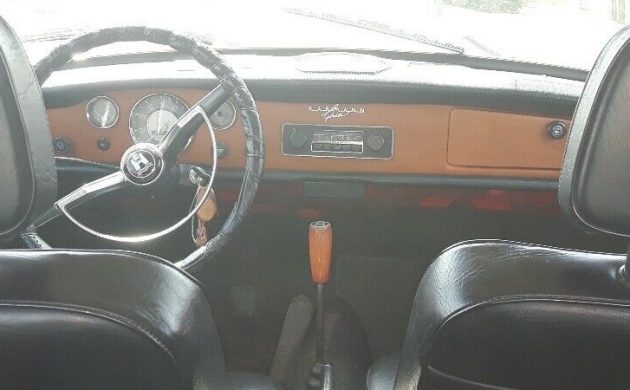
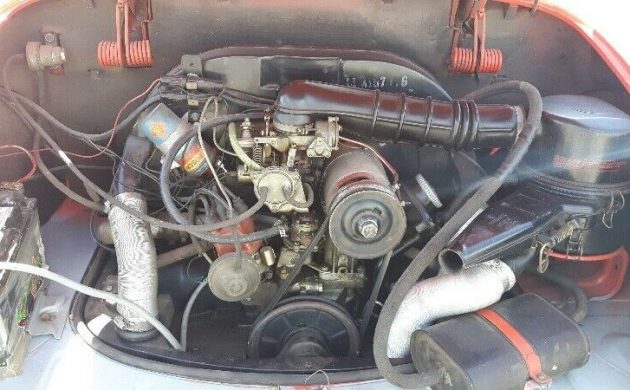
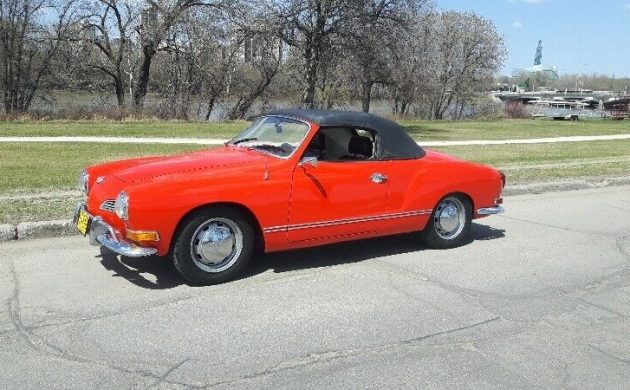

It was also made by hand for the most part. Essentially a one-piece body, sans opening doors, hood, deck. Some claim VW went to Karmann for a sports car design. But, VW wound up with something from Ghia, who had previously partnered with Chrysler and this was really a copy of a show car, Chrysler and Ghia built, that Chrysler didn’t produce, called the “D’Elegance.” I also see a lot of 356 influence. The nose isn’t damage prone if you don’t hit it against anything, it’s just damn near impossible to fix, due to the one-piece body. That one piece body is also an asset, making it more rigid. A buddy built a rotary conversion, which turned it from glacial slow to frightening.
I’ve had to straighten one of those noses: it wasn’t fun. I’ve also had to contend with typical Ghia rot. And, I’ve converted one to Type 4 power. This one appears rather nice. If I were 2000 miles closer, I’d have a look.
Also, if it’s original color, it looks like L30E, Bahia Red, which was a Ghia-only color.
The 17k$ is in Canadian dollars, so 30% discount right there for those of you South of the border.
I don’t know if I would personally agree with the sentiment that the engine is ‘barely run in’ at 71k miles. Back in the day (70’s and 80’s) I owned many air-cooled VWs, as did many of my hippie (and non-hippie) friends. With reasonable care, the consensus back then was that you could count on getting 80-100k miles out of an air-cooled VW motor, and then it was time for a rebuild. Of course some people got more miles than that (and some less). While the engines were insanely simple in both design and to work on, from my experiences I don’t remember them as being especially long-lived.
Rebuilds are straightforward and easy. The first engine I rebuilt (as a poverty-stricken college student) was a ’68 Beetle. Simple hand tools and John Muir’s classic guide and you got the job done. Care must be taken with the engine tin, which is critically important to guiding airflow around and therefore the cooling of the engine. Even nowadays I regularly see ‘rebuilt’ VW engines without all of the tin properly in place, and wonder how long the ‘rebuild’ will last if the engine regularly overheats.
Karmann-Ghias are absolutely beautiful cars. The car I courted my wife in was a 1971 Karmann-Ghia. They’re no faster than a Beetle, but have drop-dead gorgeous styling, and a feeling of quality construction I think is comparable to 356 Porsches. It’s increasingly hard to find original, unmolested examples. There was a time where for decades they weren’t particularly valuable, and many got butchered with questionable ‘performance’ upgrades or spewed on with junk from a JC Whitney catalog.
In checking out any Karmann-Ghia (or any old VW for that matter) I think it’s important to take a close look at the floor pan. They’re notorious rusters, and while replacement pans are available, you want to know what you’re getting into. I’ve found that a quick-and-dirty check of both the condition of the heater channels in the floor pan and the heater boxes is simply to turn on the heat and defroster. It’s a good sign if they work and blow clean air. But, if either nothing comes out, or if it smells like engine exhaust, its likely a sign money will need to be spent.
Nice little German sports car!! A little pricey but still nice nevertheless!!!
Um, no mention of service records to document mileage and service? For a one owner car? Sketchy.
Wow….what’s that – a nice little three times the money profit – heck who wouldn’t sell it !
It somehow, don’t ask me how, makes me think of a distant more refined relative of Little Bastard. Don’t ask why, it just strikes me that way. Apparently without the death curse however.
My sister bought one, used, sight unseen, because she had a revoked license and expected me to sort it out as her DL would soon be renewed. I picked up the car having never driven one. My two takeaways were IIRC: couldn’t tell how the thing performed as the driver’s seat was about to drop through the floor. The seat tracks wouldn’t move they were so rusty. Secondly, the seller never showed us how to get into the cargo hold! By the time we figured out how, we’d already put the “for sale make offer” sign back in the window.